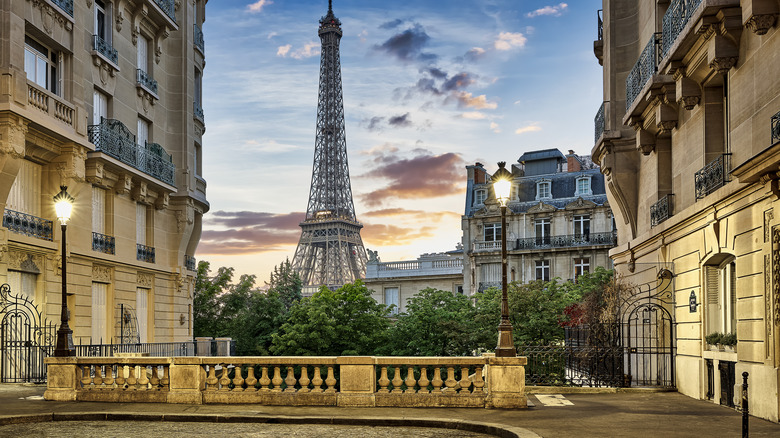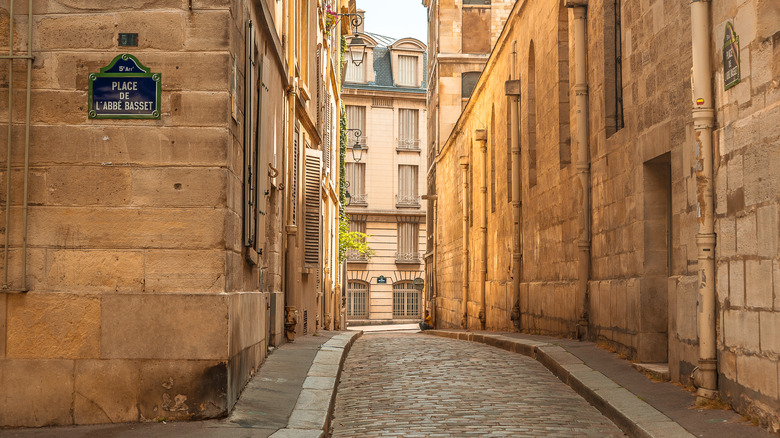One Of The World's Most Iconic Vacation Destinations Is Changing How Visitors Experience Its Streets
For most travelers, a vacation to Paris is a lifelong dream. The twinkling lights of the Eiffel Tower and the magnificent architecture draw millions of tourists to the City of Love every year. Plus, Paris has some of the most luxurious hotels you could imagine. But, due to a recent referendum, the landscape of Parisian streets may soon change. According to The World, voters in Paris have agreed on a measure to eliminate cars from at least 500 streets in the French capital. It's part of an ongoing effort by the city's current mayor, Anne Hidalgo, to reduce air pollution from road congestion in favor of more walkable areas. These efforts have been underway for several years, with limited traffic zones introduced in the city center, stretches of highway converted to pedestrian promenades, and the addition of cycling lanes on major roads. This new measure seems like a concentrated push to fully pedestrianize large parts of the city.
While it's yet to be decided which of the 500 streets will become car-free zones (via The Travel), this new initiative will likely change your experience of Paris. If you're someone who relies on taxis to get around while sightseeing in a foreign city, this might mean higher fares if taxis have to skirt around streets where vehicles are banned (though you might want to avoid taxis in Paris anyway, since tourist scams are common). Fewer cars might also mean cleaner air and quieter streets that will be more enjoyable for walking from one place to the next, allowing you to truly appreciate the iconic Parisian boulevards. And with the increase in cycling lanes, renting a bike could be a fun way to explore the city at a leisurely pace, especially if you're not keen on navigating the often crowded and hectic Paris metro system.
Paris isn't the first city to have no-car zones
Despite the gradual transformation of Paris into a more walkable city, it isn't the first tourist destination to have no-car zones. The historic center of Florence in Italy has implemented limited traffic zones since the 1990s, with most piazzas completely pedestrian-only, making the Tuscan capital's cobbled streets easily navigable by walking or cycling. Barcelona in Spain has also introduced pedestrian zones, diverting cars to the outer edges of city blocks with the interior streets limited to foot traffic and cyclists. These "superblocks" have made way for spacious tree-lined promenades bustling with recreational areas like parks with outdoor seating and playgrounds for children, turning congested roads into cozy community spaces. Denmark's capital, Copenhagen, has also invested in pedestrianized zones, where the removal of cars from streets has enhanced the atmosphere of outdoor public spaces and allowed local businesses to flourish.
While it's no small task going from a gridlocked metropolis to a walkable sprawl, much of Mayor Hidalgo's ambitions to make Paris a greener city have come to fruition. More than 200 roads around Paris have already been designated no-car zones, and a whopping 10,000 parking areas have been removed since 2020. The push towards incorporating cycle paths has also seen a 71% rise in bicycle use within the capital. Of course, no change comes without complaints. An uptick in road rage incidents has been reported due to confrontations between drivers and cyclists. Taxi drivers in particular have bemoaned the car-free initiatives for worsening congestion, meaning fewer fares for them. However, the director of the Clean Cities campaign in France, who is a proponent of the Parisian mayor's green initiatives, has noted that "every Parisian is quite conscious ... that the overall quality of life has improved" (via The World).
Great walkable neighborhoods in Paris
It will likely be a while before the new car ban across 500 streets comes into effect, so if you've got an upcoming trip to Paris, there will still be traffic. In the meantime, for a peek into what Paris might feel like with more pedestrian-only zones, why not visit some of the most iconic walkable Parisian neighborhoods, or arrondissements, as they call them? The cobbled streets of the Marais, straddling the 3rd and 4th arrondissements, is a gorgeous pedestrian district with Baroque architecture dating to the 17th century. Here you can meander through historic alleys where Parisian aristocracy once resided or pay a visit to the Picasso Museum. The 18th arrondissement, better known as Montmartre, is another fantastic walkable area famous for the hilltop Sacré-Coeur Basilica, and romantic sloping streets bustling with cute coffee shops, trendy bistros, and wine bars.
Several other areas in Paris that aren't currently pedestrianized are closed off for "Car Free Days" every first Sunday of each month. This includes the iconic Champs-Élysées avenue leading to the Arc de Triomphe, which throngs with pedestrians frolicking along the cobblestones, setting up picnics, and watching their children play. The 2nd arrondissement, which abuts the Marais district, also shuts down for Car Free Days, and is a stylish maze of cobblestone alleys around the iconic Centre Pompidou. It's here that you'll also find one of the world's oldest libraries. Consider planning your trip to coincide with the first Sunday of the month to really see Paris as you've never seen it before. And with the City of Love set to transition into an even more walkable urban jungle in the future, swapping car rentals and taxis for a good pair of walking shoes or a bicycle might become the highlight of a Parisian getaway.


